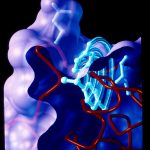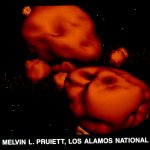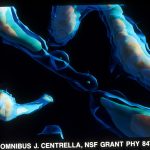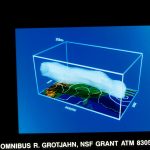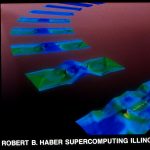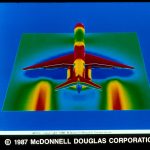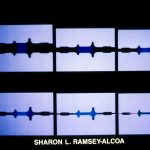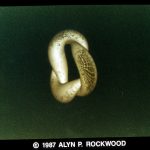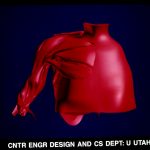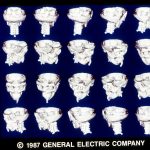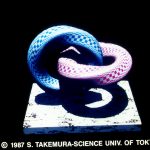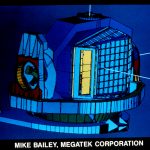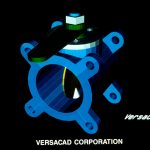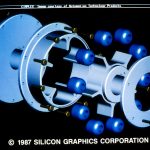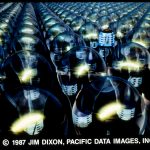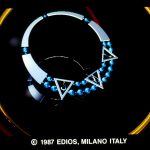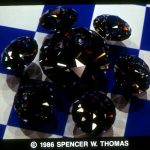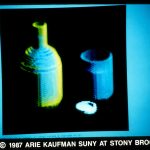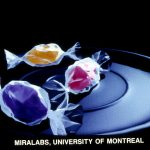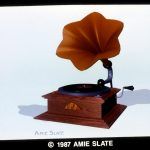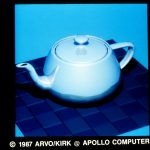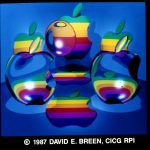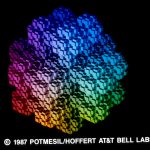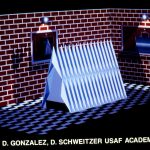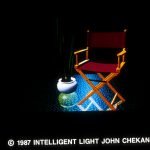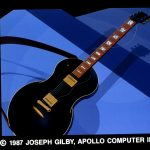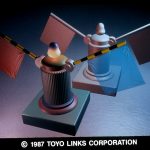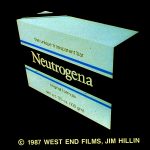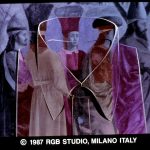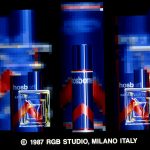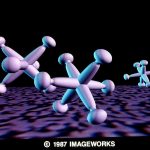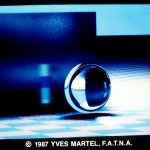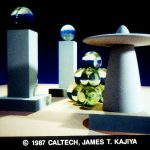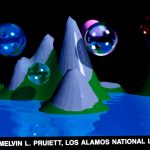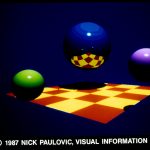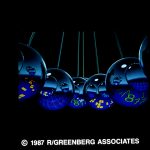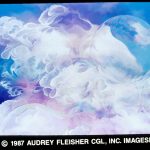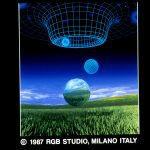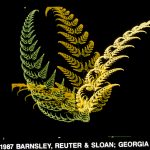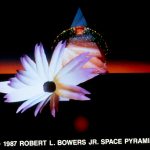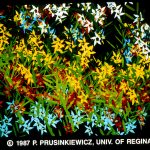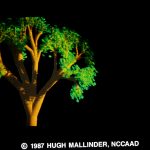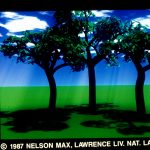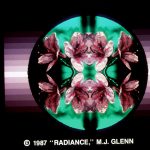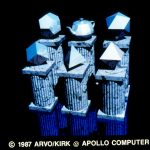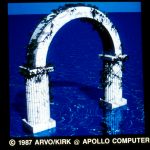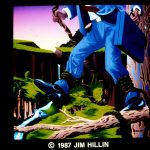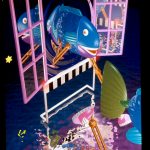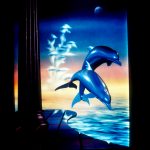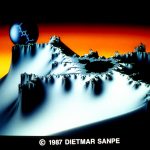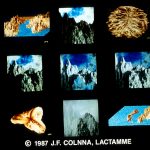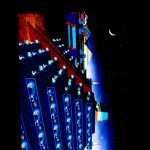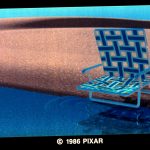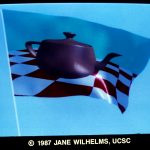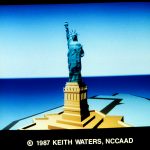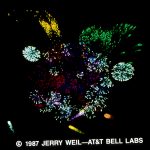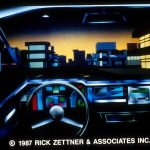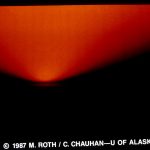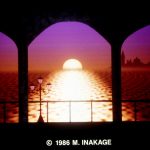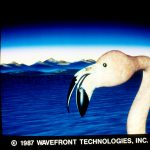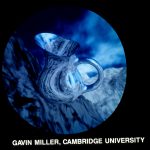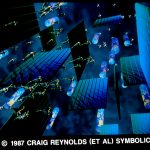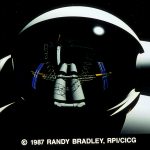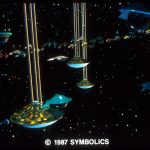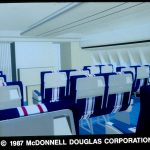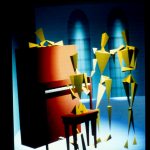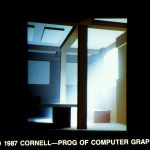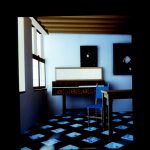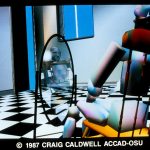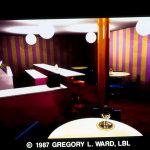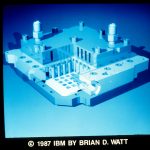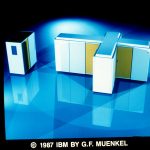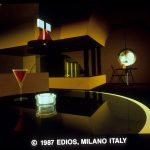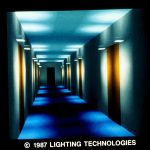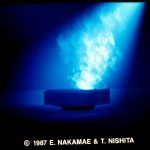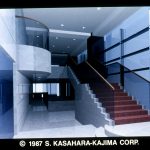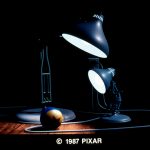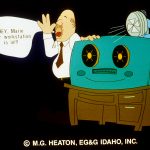“1987 Technical Slide Set”, 1987
Title:
- 1987 Technical Slide Set
Year:
- 1987
Conference:
Description:
- Michael Pique, Research Institute of Scripps Clinic, Department of Molecular Biology-Scripps Clinic, !0666 North Torrey Pines Road, La Jolla CA 92037, (619) 4579775. Proposed antibody-binding mechanism. The normally buried 6-sided tyrosine ring rotates to be outside the normal surface of the protein myohemerythrin when it is recognized by an antibody molecule (not shown). Rendered with sphere, cylinder and torus primitives using a linked-list volume model. Michael Connolly’s “M CS” Molecular Cross Section program on a Convex C-1 computer and Sun-3 workstation with 8-bit frame buffer.?
- Melvin L. Prueitt, Los Alamos National Laboratory, MS-0415, Los Alamos, NM 87545, (505) 667-4452. Asteroid Collision. This is a frame from a movie depicting asteroid collision. Produced on a Cray computer with Dicomed film recorder. Software by M.L. Prueitt.?
- Stefen M. Faugmeier, Omnibus Simulations, 3416 S. La Cienega Blvd. Los Angeles, CA 90016, (213) 938-1111. Galactic Matter. Rendition of multiple, transparent layers of galactic matter. Craig Upson and Stefen M. Faugmeier using ISOSURF model generator, DP3D proprietary rendering software on a Cray X MP/ 22 with VAX 11 / 782 front end and high-resolution digital film printer.?
- Stefen M. Faugmeier, Omnibus Simulations, 3416 S. La Cienega Blvd., Los Angeles, CA 90016, (213) 938-1111. Jetstream Field. Jetstream field over the Eastern half of the United States with sea level pressure contours. Stefen M. Faugmeier using ISOSURF model generator, DP3D proprietary rendering software on a Cray XMP/22 with VAX 11 / 782 front end and high-resolution digital film printer.?
- Robert Haber, National Center for Supercomputing Applications, 140 Computing Applications Building, 605 East Springfield Ave., Champaign, IL 61820, (217) 244-6103. Stress Waves in Dynami.c Fracture. Visualization of a Cray XMP simulation of dynamic crack growth at I km/ sec. The stress wave patterns near the crack tips in a rectangular plate are revealed by using color to represent strain energy density and vertical position to represent kinetic energy density. Hae Sung Lee, Hyun Koh and Robert Haber using Eulerian -Lagrangian moving finite element code. Ran on a Cray XMP, VAXstation II, Raster Technologies model One/380, and Matrix Instruments color graphic recorder.?
- Diane L. Hauser, McDonnell Douglas Corporation, Int. Mail Code 36-81, 3855 Lakewood Blvd., Long Beach, CA 90816 (213) 593-6681. CFO Solution. Subsonic panel method flow solution of the MD-87 with flux plane. View generated in real time by ARTIS CAE/ Post-processing package. Colors indicate pressures. By Diana Hauser, John Zulvaf and Doug Friedman using ARTIS, DACVINE on an IRIS 3030 and IBM 3081.?
- Sharon L. Ramsey, Aluminum Company of America, ALCOA Technical Center, Alcoa Center, PA 15069, (412) 337-2694. A forging we will go. Shows key frames of an animation of an aluminum forging process. Color is used to represent temperature changes during the forging process. This image was generated using in-house software, a commercially-available Finite-Element Modeler, the Evans & Sutherland PS340 and a VAX 8600.?
- Alyn Rockwood, Evans & Sutherland Computer Corp., 580 Arapeen Drive, P.O. Box 8700, Salt Lake City, UT 84108, (801) 582-5847 x4906. Three slugs playing ‘ring around the rosies’. Stereographic projection from 4D to 3-D of the classification space of homogeneous third degree polynomials in two variables (the “umbilic bracelet”). Texturing added later. By Alyn Rockwood on an E & S PS340 and VAX l l/780.?
- J. E. Wood, Center for Engineering Design, University of Utah, 3176 Merrill Engineering Building, Salt Lake City, UT 84112, (801) 581-6499. Quantitative Anatomy Study. J. E. Wood. S. G. Meek and S. C. Jacobsen, Center for Engineering Design; and R. F. Riesenfeld and T. J. V. Malley, Dept. of Computer Science; University of Utah. Thirty muscles acting about the shoulder and elbow joints of a human were digitized, then modeled with Coons’ patches and then rendered via the Alpha-I graphics system. The primary goal of the project was to get the lines of action of the muscles in order to map the muscle forces onto joint torques. The data is intended to be incorporated into a multi-axis physiologically-based prosthetic limb control scheme, wherein the muscle forces are estimated from the cutaneous EMG signals of the remnant musculature of an amputee. I’?
- William Lorensen, General Electric Corporate Research and Development, P.O. Box 8, Bldg KW/D20IA, Schenectedy, NY 12301, (518) 387-6744. Rotating Skull. 20 views of the bone surface model created from 93 CT slices. The surface model contains over 500,000 triangles. By W. Lorensen and H. Cline using marching cubes surface construction program on a Lexidata 3400, Matrix 4007 camera and a VAX 11/782.?
- Shinichi Takemura, Science University of Tokyo, 1-14-18, Gohongi, Meguro-Ku, Tokyo, 153 JAPAN 03-712-0850. Double Torus. The section of each torus is a round-cornered square by super-quadratic function. The pattern on a marble-imitated base is an application of cell-automation. By Sinichi Takemura using software he developed on a PC 9801 VM2 computer, FREE-16M frame buffer and MC 1000 digital video copy.?
- Michael J. Bailey, Megatek Corporation, 9645 Scranton Road, San Diego, CA 92121, (619) 455-5590. Untitled. This is a gimbal assembly from an aerospace application. The pieces are solidly-modeled using Geomod’M.?
- Scott Harlin, Versacad Corporation, 7372 Prince Drive, Huntington Beach, CA 92647, (714) 847-9960. Untitled. Created on the VersaCAD DESIGN software system which integrates 2D drafting and 3D surface and solids modeling, bill of materials, presentation graphic output and complete programmability.?
- Silicon Graphics, 2011 Stierlin Road, Mountain View, CA 94043, ( 415) 960-1980. Exploded View.?
- Jim Dixon, Pacific Data Images, 1111 Karlstad Drive, Sunnyvale, CA 94089, (408) 7456755. 793,900 polygons were rendered with the bulbs reflecting a beach in the Virgin Islands. The “glass” is transparent with an angular dependency, increasing the perception of density. By Jim Dixon on the Pacific Data Images proprietary animation system with Ridge computers and Raster Tech frame buffer.?
- Giovanni della Rossa, EIDOS, Via Fontana, 16,20122 Milano, ITALY. Jewelry Sequence. Simulation and presentation of articles of jewelry. Raytracing and CGS modeling techniques. Data General MV-8000, Apollo DN580, DN3000 and DN660, Evans & Sutherland PS300, Hamamatsu TV-scanner and Polhemus 3-D digitizer all running EIDOST A TION (Eidos proprietary software.)?
- SpencerW. Thomas, Department of Computer Science, The University of Utah, Salt Lake City, UT 84112, (801) 581-3095. Diamonds. Computed on VA and Apollo computers, this image demonstrates simulation of dispersive refraction using ray tracing.?
- Arie E. Kaufman, Department of Computer Science, SUNY at Stony Brook, NY 11794-4400, (516) 632-8441. Bottle and Glass. A geometric model of cylinders is scan-converted into 1283 cubic frame buffer of voxels, and projected and rendered with semi-transparent bottle and glass and discrete shading. By Kaufman and Liow using Sun Core, Sun View and CUBE architecture software on a Sun 3-160C.?
- Nadia Thalmann, MIRALab, 5255 Av. De celles, Montreal, Canada, (514) 340-6616. Candies. Ths is made with fractals with the software Human Factory. By N. Magnenat-Thalmann and D. Thalmann, software Human Factory.?
- Amie Slate, Cubicomp, Corp. 21315 Cabot Blvd., Hayward, CA 94545, (415) 887-1300. Whole Notes. This data base was created with extensive use of cross sectional modeling and rendered with texture mapping, Phong shading and multiple light sources. Rendered at 2048 x 1365 and took one hour on an IBM PC AT. By Amie Slate using Cubicomp Picturemaker on an IBM PC AT with Samurai camera.?
- David Kirk, Apollo Computer, MS CHF-02-RD, 330 Billerica Road, Chelmsford, MA 01824, (617) 256-6000 x7789. Mirror Teapot. Ray tracing accelerated by five dimensional ray classification. By James Arvo and David Kirk using Apollo DN580 Turbo with floating point accelerator.?
- David E. Breen, Center for Interactive C.G., Rensselaer Polytechnic Institute, Troy, NY 12180, (518) 266-6482. Apple Gallery #2. This is a ray traced image where the apples are extruded polygons intersected with superquadrics. By David E. Breen using the Clockworks Computer Animation System on a Data General MV / 10000, E&S PS300, Raster Technologies Model I/ 20 and Dunn Instruments Camera 635.?
- Michael Potmesil, Eric M. Hoffert, AT&T Bell Labs, Crawfords Corner Road, Holmdel, NJ 07733, (201) 949-1585. Inverted menger sponge. A 3D self-similar fractal object modeled by octrees and voxels. The volume of the sponge approaches zero and its surface area approaches infinity as the number of recursions levels increases. By Michael Potmesil and Eric M. Hoffert using FRAMES (image-rendering software tools) on a VAX l l /785 with an Ikonas frame buffer.?
- Deam W. Gonzalez, USAF Academy, USAF A/ DFCS, Colorado Springs, CO 80840, (303) 472-2136. USAF Academy Cadet Chapel. This “Escher-like” rendering of USAF Academy Cadet Chapel was made with multiple renderings of the model from different views. The final rendering contains texture maps of previous renderings which contain texture maps of previous renderings which …. Distributed ray tracing used for antialiasing, binary space partitioning used for decreasing rendering time. By Dean Gonzalez with ray tracing software developed by Dean Gonzalez and D. Schweitzer in ADA using the Data General MV / I 0000 and Ramtek 4225 64 color display device.?
- John Chekan, Intelligent Light, P.O. Box 65, Fairlawn, NJ 07410, (201) 794-7550. On Worms. Detailed textured model of directors chair with potted plant and textured base. By John Chekan using Intelligent Light GW-3000 workstation, Apollo workstations, Ikonas frame buffer and Dunn 632 film recorder.?
- Joseph Gilby, Apollo Computer, MS CHF-02-RD, 330 Billerica Road, Chelmsford, MAO 1824, (617) 256-6600 x7582. B-String Blues. The slide shows various linearly distorted primitives, a bicubic surface tessellated with cylinder sections and two FEM ‘strings’released under tension, acting as environmentally sensitive automata. James Arvo and David Kirk created the turbulent solid texture software for the pearl inlays and the ray classification, 5-space algorithm. The 512 x 480 x 24 image was computer in one hour on eight various Apollo nodes (networked 570’s, 580’s, 580T’s and 3000’s -scene distributed into 8 strips).?
- Taku Kimura, Toyo Links Corporation, New Shinsaka Bldg, 8-10-22, Akasaka, MinatoKu, Tokyo, Japan, 03-423-1681. Mapping Combination.?
- Karen D. Miller, West End Film, 1825 Q Street, N.W., Washington, D.C. 20009, (202) 232-7733. Artist: Jim Hillen.?
- Don Riley, Time Arts Inc. P.O. Box 6476, 3436 Mendocino Avenue, Santa Rosa, CA 954060476, (707) 576-7722. Artist: Tullia Redaelli Spreafico of RGB Studios, #17 Viale Piave, Milano, Italy.?
- Don Riley, Time Arts Inc. P.O. Box 6476, 3436 Mendocino Avenue, Santa Rosa, CA 954060476, (707) 576-7722. Artist: Tullia Redaelli Spreafico ofRGB Studios,# 17 Viale Piave, Milano, Italy.?
- Karen Fox, Imageworks, (213) 393-8075.?
- Yves Martel, F.A.T.N.A., 5048 Victoria Ave., Montreal, Quebec, Canada, H3W 2N3, (514) 731-9556. The Caustic Ray. This image was computed at a resolution of 450 x 300 x 24 with an adaptive distributed ray tracing algorithm incorporating caustic rays to model the effects of the lens. Highlight on the floor, inverted image on the screen. By Yves Martel on a VAX 8600 with Comtal Vision I display system.?
- James T. Kajiya, Caltech, 256-80 Computer Science, Pasadena, CA 91125, (818) 356-6254. The Rendering Equation.
- Melvin L. Prueitt, Los Alamos National Laboratory, MS-0415, Los Alamos, NM 87545, (505) 667-4452. A Quiet Day. The transparent spheres have reflection and refraction. The water has reflection. Produced on a Cray computer with Dicomed film recorder. Software by M. L. Prueitt.?
- Nick Paulovic, Visual Information Inc., P.O. Box 1674, West Covina, CA 91793. Untitled. Raytraced on a Macintosh Plus taking 12 hours. Displayed upon a Macintosh II computer with the SuperMac Spectrum 1024 graphics board and the Amtron 19″ monitor.?
- Jan Carlee, Rf Greenberg Associates, 350 West 39th Street, New York, NY 10018, (212) 2396767. Integration. Image from the 1987 Bell Atlantic campaign commercial. The CGI director was Jan Carlee.?
- Audry Fliesher, Computer Graphics Lab Inc., 405 Lexington Ave 59th Floor, New York, NY 10174, (212) 557-5130. Bubble Migration. 2000 line raster image using CGL’s Images 11 + 24 bit paint system which allows for raster painting beyond normal 512 x 486 pixels.?
- Don Riley, Time Arts Inc., P.O. Box 6476, 3436 Mendocino Avenue, Santa Rosa, CA 954060476, (707) 576-7722. Space Corn. The Scan-Line software package is used by the artist to rasterize vector files and allow the artist to paint on top of the raster image for desired lighting, shading and other effects. Tullia Redaelli Spreafico of RGB Studios,# 17 Viale Piave, Milano, Italy; Massimo Ontani, artist.?
- Laurie Reuter, Georgia Tech School of Mathematics, Georgia Tech, Atlanta, GA 30332, (404) 894-2574. 3-D Ifs Ferns. These are several views of the same 3-D iterated function system encoded fern. The data base consists of four affine transformations. By Michael Barnsley, Laurie Reuter and Alan Sloan using Masscomp 5600 with Aurora Graphics, and Dunn Instruments camera system.?
- Robert L. Bowers Jr., The Ohio State University, Advanced Computing Center for Art and Design, 1501 Neil Ave., Columbus, OH 43201, (614) 2923416. Space Pyramid VI. Threedimensional data base with texture mapped trangle components-petal color with vertex colorihg. By Robert L. Bowers Jr. with local OSU software on a VAX 11 /780 computer.
- Przemyslaw Prusinkiewicz, University of Regina, Department of Computer Science, Regina, Sask., Canada S4S 0A2, (306) 584-4061. Flower Field. Sixteen plants with flowers, modeled using a stochastic Lsystem. The randomness is introduced to provide specimen-tospecimen variations within a species. An in-house developed software package was used for modeling plants based upon the Lindenmayer systems. The computer was a Sun 2/ 160.?
- Paul Brown, Nat’! Cent. for CA Art and Design, Middlesex Polytechnic, Cat Hill, Barnet, Hertfordshire, EN4 8HT England 440-5181 x5104. Tree. By Hugh Mallinder with assembly code on a Z80. The image contains branches, semi-transparent leaves and shadowing.?
- Nelson Max, L 30 I, Lawrence Livermore National Lab, P.O. Box 808, Livermore, CA 94550, (415) 422-4074. Light Beams. The bark bump map was measured from actual maple bark and rendered with shadows from the bumps. The shadows ofleaves on the ground and in the haze were computed as described in SIGGRAPH ’86 proceedings pages 117-124. By Nelson Max and Jules Bloomenthal using a Cray XMP computer with the Dicomed D48 color film recorder.?
- Mary Jane Glenn, Glenn Graphics, P.O. Box 1254, Ronkonkoma, NY 11779, (516) 7371256. Radiance. Digitized photo image of natural form, custommade palette with opaque and tint brushes were used. Detail was selected from image, painted, enlarged, repeated and manipulated to create a mandala form. Used CGL images II+ paint system.?
- David Kirk, f\pollo Computer, MS CHF-02-RD, 330 Billerica Road, Chelmsford, MA 01824, (617) 256-6600 x7789. The Six Platonic Solids I. Ray tracing accelerated by five dimensional ray classification. By James Arvo and David Kirk using Apollo DN580 Turbo with floating point accelerator.?
- David Kirk, Apollo Computer, MS CHF-02-RD, 330 Billerica Road, Chelmsford, MA 01824, (617) 256-6600 x7789. Arch and Ivy. Ray tracing accelerated by five dimensional ray classification. Ivy grown by environment-sensitive automation which interacts with environment through ray tracing. By James Arvo and David Kirk using Apollo DN580 Turbo with floating point accelerator.?
- Jim Hillin, 1309 Palisades Drive, Pacific Palisades, CA 90272, (2 I 3) 459-4292. Think Again. By Jim Hillin using Time Arts’ Lumena 8 paint package with high resolution driver on a Sperry PC-IT, Number Nine 8 bit color graphics card, Kurta digitizing tablet and matrix QCR.?
- Chisako Ito, Toyo Links Corporation, New Shinsaka Bldg, 8-10-22, Akasaka MinatoKu, Tokyo, Japan, 03-423-1681. Domo domo domo 1.?
- Larry Schnur, Wavefront Technologies, 530 East Montecito Street, Santa Barbara, CA 93103, (805) 962-8117. Dolphin. Shows multi-level compositing, texture mapping, reflection mapping and multiple light sources, Art direction: Bruce Jones; technical direction: John Grower. 50. Dietmar Sanpe, Dept. of Mathematics, Universitat Bremen, 2800 Bremen-33, W. Germany. Untitled. Potential of a satellite Mandelbrot set with Julia set on moon. By H. 0. Peitgen, H. Jurgens and D. Sanpe using Iris 3030 at 1024 x 768.?
- J. F. Colonna, Lactamme, Ecole Polytechnique, 91128 Palaiseau Cedex, France 33 I 60 19 40 53. 3D Synthetic Landscape and Planets. By J. F. Colonna with his own software on Solar 16.65 computer.?
- Tomas J. Filsinger, 732 Williams Circle Dr., Chapel Hill, NC 27514, (919) 967-4530. Teotihuacon. The city of the Gods. Based on archaeological maps. Digitized on an E&S PS300 at the Center for Experimental Computer Science, UCLA. Project director Robert “Buz” U zgalis. CAT scan plasticine serpent head. Multi-planar diagnostic imaging ink. Research, digitizing and art direction by Tomas J. Filsinger. Technical direction by Brad Hunt. Rendered at Abel Omnibus Simulation Inc.?
- Susan Catmull, PIXAR Inc., P.O. 13719, San Rafael, CA 94913, ( 415) 499-3600. Beach Chair. Ralph Guggenheim, director of animation services. Beach Chair is a short film produced by Pixar. The film depicts the brief journey of an intrepid peice of leisure-time furniture. Animation for the film was procedurally generated using software developed at Pixar. Ripples. reflections and refraction on the water are simulated using surface descriptions, including procedural texturing, displacement maps and texture maps. Final rendering of the images includes full self-shadowing and accurate motion-blur of the action. Eben Ostby-Models, animation and rendering. Gary Rydstrom and Craig Good-sound. Don Conway-laser film scanning. John Lasseter-beach texture.?
- Jane Wilhelms, University of California, Santa Cruz, Computer and Information Sciences, Applied Sciences Building, Santa Cruz, CA 95064, (408) 429-2990. Untitled. The flag is modeled using finite element analysis as masses connected by springs and acted upon by an external wind force. By Matt Moore using the University of Toronto 3D Rendering Package, and U CSC modeling and animation software.?
- Paul Brown, Nat1 Cent. for CA Art and Design, Middlesex Polytechnic, Cat Hill, Barnet, Hertfordshire, EN4 8HT England 440-5181 x5104. Statue of Liberty. By Keith Waters using Picaso and Prism software running on a VAX 785.?
- Jerry Weil, AT&T Bell Laboratories, 600 Mountain A venue, Murray Hill, NJ 07974, (201) 582-7833. 4th of July. Single frame from animation of fireworks. By Jerry Weil with inhouse software for animating fireworks running on a VAX 11 /750 and Adage RDS3000.?
- Michele Glenn, Rick Zettner & Associates, Inc., 211 North Victory Boulevard, Burbank, CA 91502, (818) 848-7673. Looking for Parts. Two different computer-generated cities, each utilizing extensive texture and reflection mapping, were created for a pair of Checker/ Kragen auto parts spots. By John and Phillip Hom, designers; Clark Anderson, creative director; Tim Landry and Dorne Huebler, designers/directors; Peter Blinn and Darlene Hadrika, technical directors. Software was the Abel Image Research package running on the Silicon Graphics Iris 3030.?
- Mitchell Roth, University of Alaska-Fair banks, Department of Mathematical Science, JO I Chapman Bldg., Fairbanks, AL 99775, (907) 474-7098. Sunset on Mach Bay. The shading of a curved surface approximated by non-planar polygons is illustrated in this image. The surface is a section of a cylinder viewed from the inside with decreasing radius from left to right. The cylinder is approximated by three nonplanar quadrilaterals. The inside of the cylinder is illuminated by a light source using a fast Phong shading technique. Specular reflection in the top half of the image resembles a sunset, while diffuse reflection in the lower half of the cylinder creates intensity contours resembling waves on a beach. The apparent crests and troughs in these waves are an illusion caused by the Mach effect. In reality each “wave” is a uniformly illuminated contour at one of 64 intensity levels. By M. Roth and C. Chauhn using C language polygon shading routines running on a Masscomp MC-5500 workstation.?
- Masa Inakage, 1-23-12 Nakane, Apt. 20-D, Meguro, Tokyo, 152 Japan 03-718-2623. Venetian Romance. The ocean is ray traced while others are 2D images and composited. Intensity mapping (2D bump map) is used for the front stone texture. The software was written by Masa lnakage and runs on the NEC PC-9801 VM2 personal computer with a 36 bit frame buffer from YDK Inc.?
- Larry Schnur, Wavefront Technologies, 530 East Montecito Street, Santa Barbara, CA 93103, (805) 962-8117. Flamingo. Three dimensional image modeled on Iris 3130. Textures mapped onto 3D shapes using Wavefront Image software. Design and construction: John Grower. Textures: Bruce Jones.?
- Gavin S.P. Miller, Alias Research Inc., l JO Richmond St. East, Toronto, Ontario, Canada MSC IP!, (416) 362-9181. Magritte’s Milk Jug. The jug was rendered using an A-buffer with a reflection map of the fractal landscape. The reflection map was created using scanline algorithms acting on a spherical projection of the terrain. DUCT Surface Modeler plus artist’s graphics code running on a Prime 2655 computer and a Sigmex 7000 series frame buffer.?
- Craig W. Reynolds, Symbolics, Inc., Graphics Division, 1401 Westwood Blvd., Los Angeles, CA 90024, (213) 478-0681. Behavioral Animation of Schools and Flocks. This image is a frame from “Stanley and Stella in: Breaking the Ice” (Film show SIGGRAPH ’87.) We are looking up from Stella’s world, in the foreground is a school of stylized fish and in the distance through the city barrier we see a flock of birds. The motion of the flock and school is determined by a distributed model based on the behavior of each individual fish or bird as it responds to its local environment. Produced by the combined production staff of Symbolics Graphics Division, Whitney/ Demos Productions and Hitman of Design. Used the Symbolics “S-” software. Behavioral animation created with the Boids system which is layered on top of S-Geometry and S-Dynamics on a Symbolics 3600 computer.?
- Randy Bradley, Center for Interactive C. G ., Rensselaer Polytechnic Institute, Troy, NY 12180, (518) 266-6751. Shuttlestop. This ray traced image (1280 x 1024) reflects the latest dual-keel Spacestation design in the faceplate of an astronaut’s helmet, while the sun reflects as well. Modeling utilized superquadric primitives throughout. Dubbed “Shuttlestop” as the terminus for the shuttle and the next stop for man in space. By Randy Bradley using the Clockworks image synthesis/ simulation system. Developed by the RPI/ CICG animation group running on the DG MV-10000, Raster Tech One/380, E&S PS300 and Dunn 635.?
- Craig W. Reynolds, Symbolics, Inc., Graphics Division, 1401 Westwood Blvd., Los Angeles, CA 90024, (2 I 3) 4 780681.?
- Diana L. Hauser, McDonnell Douglas Corporation, Int. Mail Code 36-81, 3855 Lakewood Blvd., Long Beach, CA 90816, (213) 593-6681. First Class Graphics. Computer generated image using ABEL software. Interior design by Allen Johnson, used for sales and interior planning. The MD-I I has not been made yet. This interior is the plan for first class. By Allen Johnson and Diana Hauser using Abel software on the Iris 3030.?
- Norman Hadler, University of, Pennsylvania, Computer Graphics Research Lab. Philadelphia, PA 19104, (215) 8981976. Piano Bar. By Jan Rovins. Four golden polygonal figures grooving to good tunes. Caricature rendering system by Cary Phillips. Tempus-group project on a VAX l l /785.?
- Holly E. Rushmeier, Cornell University Prog. of Computer Graphics, 120 Rand Hall, Cornell University, Ithaca, NY 14650, (607) 255-6704. Smoky RoomAfternoon II. Light intensities in this scene are calculated using the zonal method which accounts for all volume/volume, volume/surface and surface/surface interactions.?
- John R. Wallace, Cornell University Prog. of Computer Graphics, 120 Rand Hall, Cornell University, Ithaca, NY 148535501, (607) 255-6715. Glossy Floor, after Vermeer. Illumination calculated ming a hybrid of radiosity and distributed ray tracing. By John R. Wallace using a VAX 8700 and displaying at 1280 X 1024.?
- Craig Caldwell, Advanced Computer Center for the Arts and Design, 150 I Neil Ave., Columbus, OH 43201, (602) 5234936. What in the World? The background consists of amorphic shapes from animation “metafable.” Room and window were put on top of that. Window is transparent with man’s reflection and light reflection. Man looking put in last. By Craig Caldwell using TWIXT by Julian Gomez and in-house software by Paul MacDougal and John Renner.?
- Gregory J. Ward, Lawrence Berkeley Laboratory, I Cyclotron Rd. 90-3111, Berkeley, CA 94720, (415) 486-4757. Untitled. Custom ray tracing on a VAX 11 /780 and Dicomed film recorder.?
- Brian D. Watt, IBM Corporation, D/Cl3 B/703-2, P.O. Box 390, Poughkeepsie, NY 12602, (914) 435-1617. TCM. A sectioned view of an IBM Thermal Conduction Module (TCM) for the system packaging of the IBM 3090. By Brian D. Watt using an in-house solid modeling system with ray tracing software developed jointly with RPI-CICG. Computed as a 1024 x 1024 x 24 image on an IBM 3081 and displayed on an IBM 5080.?
- G. F. Muenkel, IBM Corporation, D/803 8/701, P.O. Box 390, Poughkeepsie, NY 12602, (9 I 4) 435-1036. 3090. Model generated during product development phase for industrial design appearance study of IBM 3090200 machine. By G. F. Muenkel using an in-house solid modeling system with ray tracing software developed jointly with RPICICG. Computer as a 1024 x 1024 x 24 image on an IBM 3081 and displayed on an IBM 5080.?
- Giovanni della Rossa, EIDOS, Via Fontana, 16,20122 Milano, IT ALY. Bar Sequence. Simulation and presentation of an environment. Ray tracing and CGS modeling techniques. Data General MV-8000, Apollo DN580, DN3000 and DN660, Evans & Sutherland PS300, Hamamatsu TY-scanner and Polhemus 3-D digitizer all running EIDOST A TION (Eidos proprietary software).?
- Steve Stannard, Lighting Technologies, Inc., 3060 Walnut St. #209, Boulder, CO 8030 I, (303) 449-5791. Corridor. Full interreflection of lighting model, subject slide took only 21 minutes to calculate and produce. Lumenmicro lighting analysis program developed by Lighting Technologies, Inc. running on an IBM PC AT with AT&T Targa 16 and a Dunn film printer.?
- Eihachiro Nakamae, Saijo, Higashihiroshima, Hiroshima 724, Japan 0824-22-7111. Smoke in the shaft of light. A shading model for atmospheric scattering considering particle density is used to make the image. By E. Nakame (Hiroshima University) and T. Nishita(Fukuyama University) using TOSBAC DS-600 computer and GRAPHICA M508 display.?
- Shinichi Kasahara, Information Processing Center, Kajima Corporation, 1-1 Nishishinjuku 2-chrome Shinjuku-ku, Tokyo, 160 Japan (03) 344-2111. Entrance Hall. The ray tracing software is linked to the CAD system. This image was generated using a building model which has been designed by CA TIA. Resolution is 1024 x 702. By Shinichi Kasahara with REAL, which is an in-house ray tracing software package on an IBM 4361, IBM 5080 and Dicomed film recorder.?
- Susan Catmull, PIXAR Inc., P.O. Box 13719, San Rafael, CA 94913, (415) 499-3600. Luxo Jr. Ralph Guggenheim, director of animation services. A frame from the award winning film, first shown at SIGGRAPH ’86 in Dallas, Texas. Luxo is a trademark of Jae Jacobsen Ind. John Lasseter-direction, animation, models. Bill Reeves-technical direction, models, rendering. Eben Ostby-models, animation and rendering. Sam Leffler-rendering. Rob Cook-rendering. Don Conway-laser film scanning.?
- M. Gene Heaton, EG&G Idaho Dept. of Energy, Idaho National Eng. Lab, P.O. Box 1625, Idaho Falls, ID 83415, (208) 526-9154. Cartoon Concept. Humor in computer graphics with the Computer Visual System running on the Cyber 176 with AED 767 terminal and a Dicorned D48 film recorder.
SIGGRAPH ’87 Technical Slide Set Credits?
Edited by Bruce Eric Brown?
The technical slide set represents examples of the latest work in computer graphics demonstrating technical expertise. Each slide is printed here in black and white to facilitate locating information about the images. The full color 35mm slide set can be ordered from: ACM order department, P.O. Box 64145, Baltimore, MQ 21264; 1-800-342-6626. The ACM order number for the SIGGRAPH ’87 technical slide set is 9 I 5870. The cost is $30 for members; $40 for non-members.?
Publication Documents:
1987 Technical Slide Set Images:
